Considerations When Choosing an Air Compressor
Forget choosing the best air compressor—choosing any air compressor for any task requires that you understand a few key things. You need to know what CFM means, how the cycle rate affects your airflow, and the form factor you need (portable stack, pancake-style, standing tank, etc). When choosing the best air compressor for a home garage, we lean towards standing tanks. We do, however, recognize that some don’t want to (or need to) buy multiple air compressors, so we’ll also make some picks in the portable category as well. Before you choose, go through the following to understand your particular needs.
Editor’s Note: You may also want to see our recommendation for the best air compressor overall.
Air Compressor Type
One of the first things you want to decide is what type of air compressor you want. While some may want a standing tank that never moves from the corner of their garage or shop, others may desire something more portable. If you decide on a fixed tank, longer air hoses can get you just about anywhere you want. If, however, you plan to take your air on the road to do a job, that standing tank won’t be much help. Standing air compressors also take up a permanent place in your garage, so you lose some flexibility when it comes to storage.
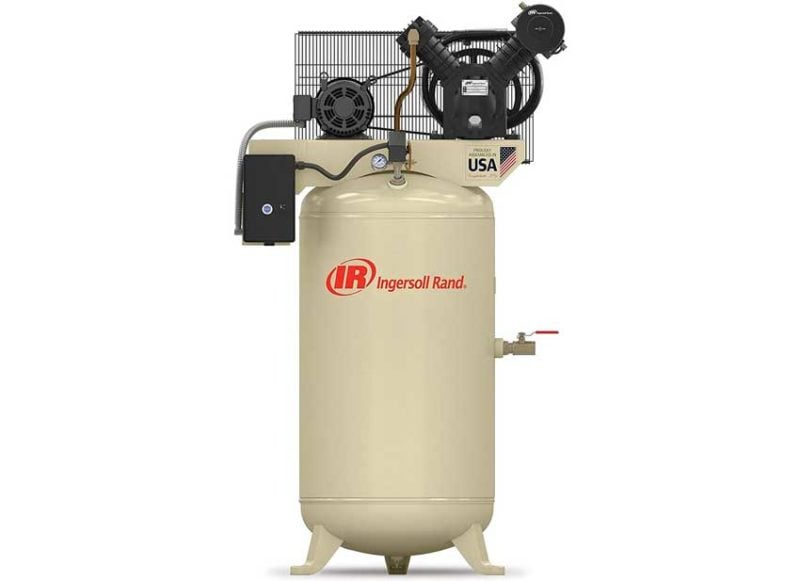
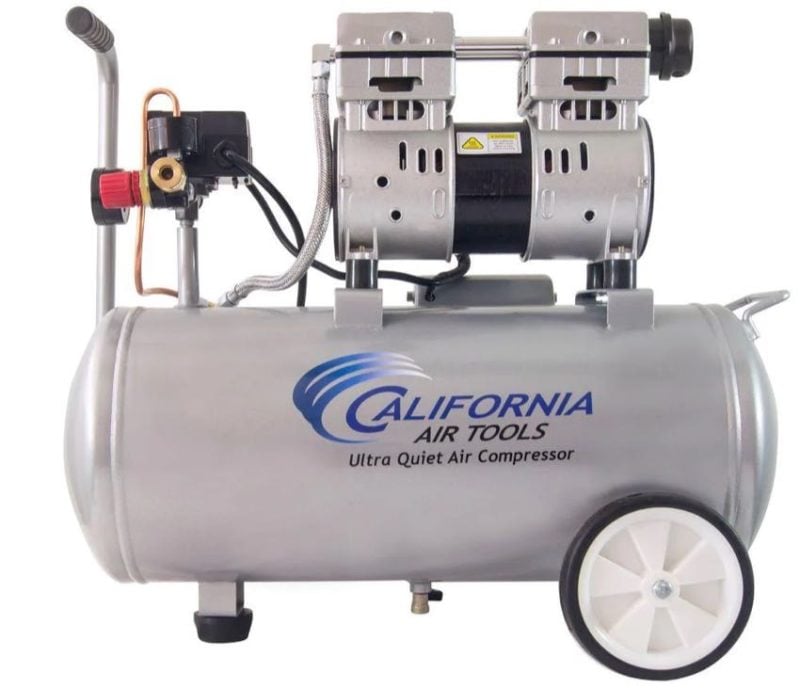

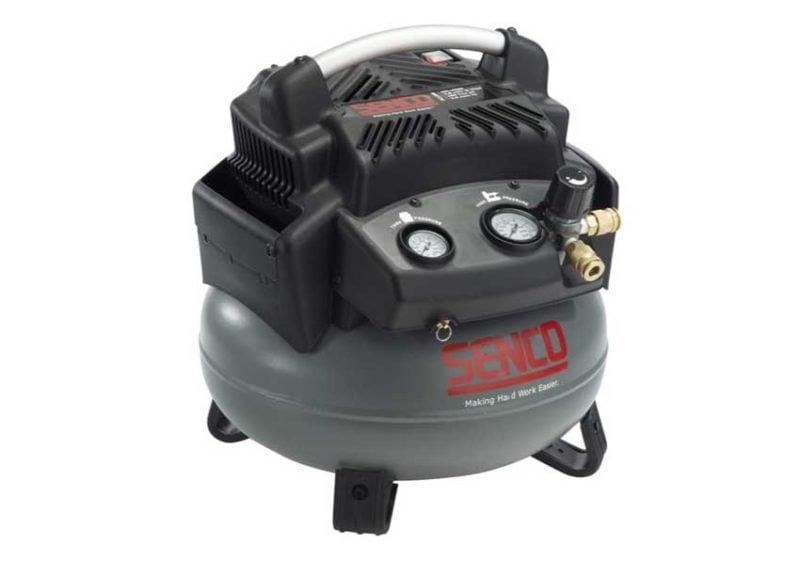
A good compromise might be a larger 4–8 gallon jobsite air compressor. They make these in a variety of styles and some offer an excellent amount of both airflow and short cycle time to refill the tank. If you do decide to go portable, another decision involves choosing the “hot dog” style tanks or a “pancake” air compressor. In our opinion, hot dog compressors typically work best in a garage as they typically come with wheels (at least models 4-gallons or higher). Pancake compressors never include wheels and have a lower center of gravity and a wider base for use on roofs or anywhere you don’t want it to roll away.
Airflow or Cubic Feet per Minute (CFM) or (SCFM)
When operating a finish nailer, you don’t need a ton of airflow or CFM. However, if you want the best air compressor for your home garage, you might want to support the use of air tools like impact drivers, pneumatic ratchets, and air sanders. Those require considerably more airflow or CFM. How much more? Assuming 90 PSI, you can drive a small finish nailer with just 0.3–0.5 CFM. Contrast that to an air ratchet which requires 3-7 CFM depending on its size. Want to use an air sander? That requires upwards of 11 to 13 CFM or more. You need a larger tank if you want to support those higher cubic feet-per-minute demands. Plan and buy accordingly.
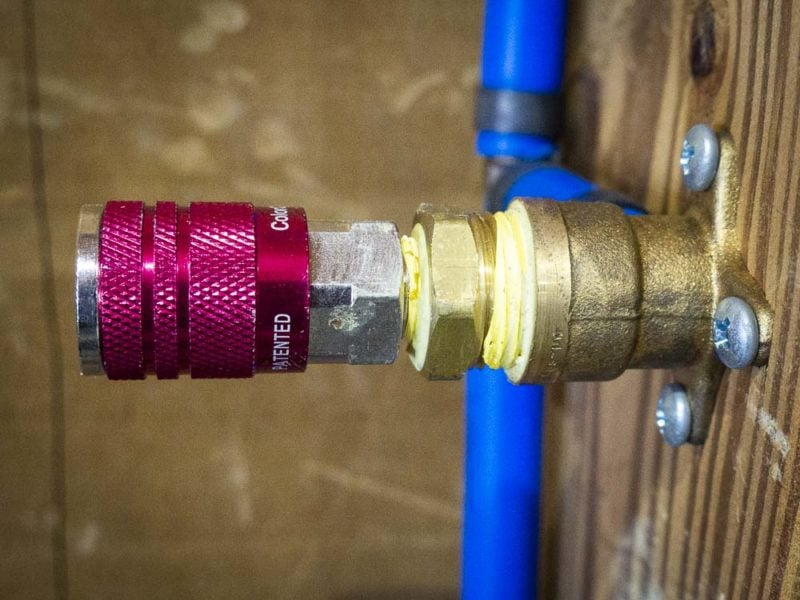
Pressure or PSI (Pounds per Square Inch)
When it comes to PSI ratings, most air compressors can handle the air pressure requirements of basic air tools. Many tools operate just fine around 90 PSI. Some tools, like framing nailers, want a bit more—around 100-120 PSI for maximum penetration into LVL and similarly hard materials. You may see many air compressors rated at 90 PSI for their airflow (SCFM) ratings. When you begin using more air pressure, those CFM rates drop.
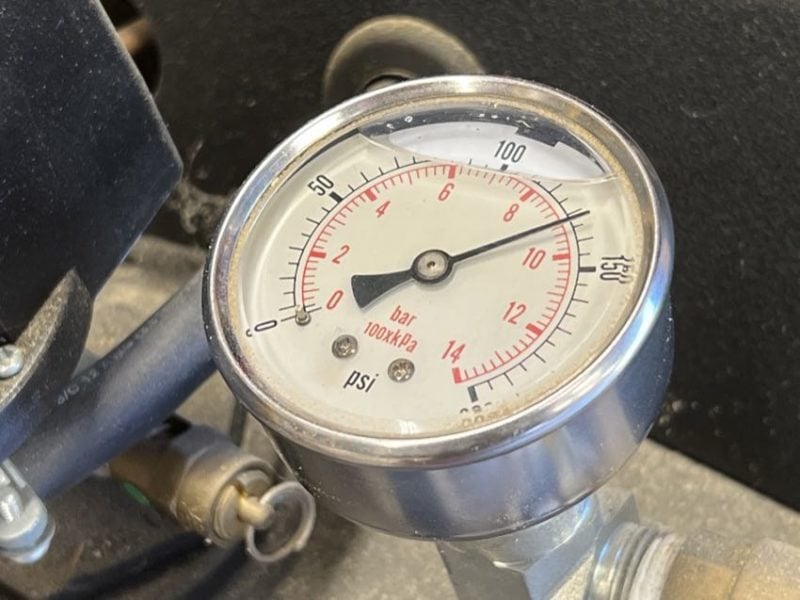
If you plan to use pressure-hogging tools like tire inflators, grease guns, and (multiple) framing nailers, be sure your compressor is big enough to keep up. This also leads to our next spec and consideration.
Duty Cycle Time
The duty cycle (or cycle time) refers to the amount of time between successive times a compressor refills. If your compressor generated air but had no tank, it would operate at 100% duty cycle. Some compressors are rated at 100% duty cycle, meaning they can deliver the spec’d pressure at the rated PSI continuously. That doesn’t mean they can run forever, however. At some point—unless you have a “continuous run” compressor, the system has to stop and give the pistons a break.
With respect to the duty cycle time, you need to ensure that your compressor can supply the proper pressure and volume of air for the tools you intend to use. That means that if you want to use an air sander at 13 CFM at 90 PSI, you likely need a decent-sized tank so you don’t have to stop and wait for it to refill if you quickly blow through all your available air.
A pneumatic nailer can suffer a shorter duty cycle just fine since it only requires a burst of high pressure. A continuous tool like an air ratchet, sander, or tire inflator, requires a faster fill rate for the tank, or a larger tank to keep up with the demands of the tool. Of course, this leads directly into our next feature.
Best Tank Size for a Home Garage
We’ve covered some of this above, but the size of your air compressor tank determines how much air you have to use before it needs to be refilled by the compressor. Our preference for the best air compressor for a home garage would include a larger tank—perhaps as much as 60 or 80 gallons. You can go higher, of course, but 60-80 fulfills a lot of applications for a garage or small workshop.
If you want something that supplies a decent amount of air but remains portable, an 8-gallon or 10-gallon model might make more sense. These come as either “wheelbarrow” style (see our Makita Big Bore air compressor review) or as a portable vertical tank style. The latter looks almost like it has an integrated dolly. A third type resembles an oversized “hot dog” style compressor.
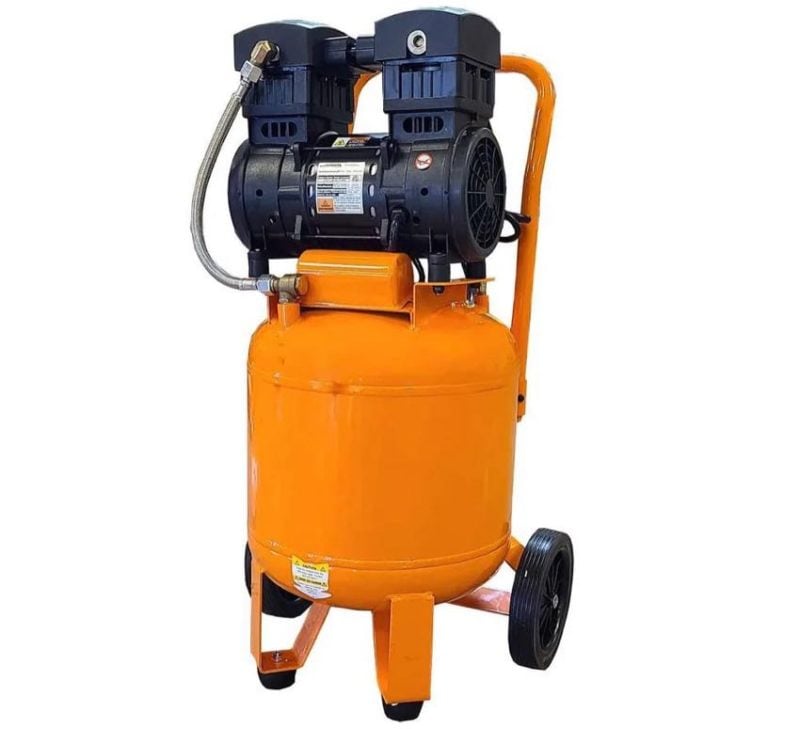
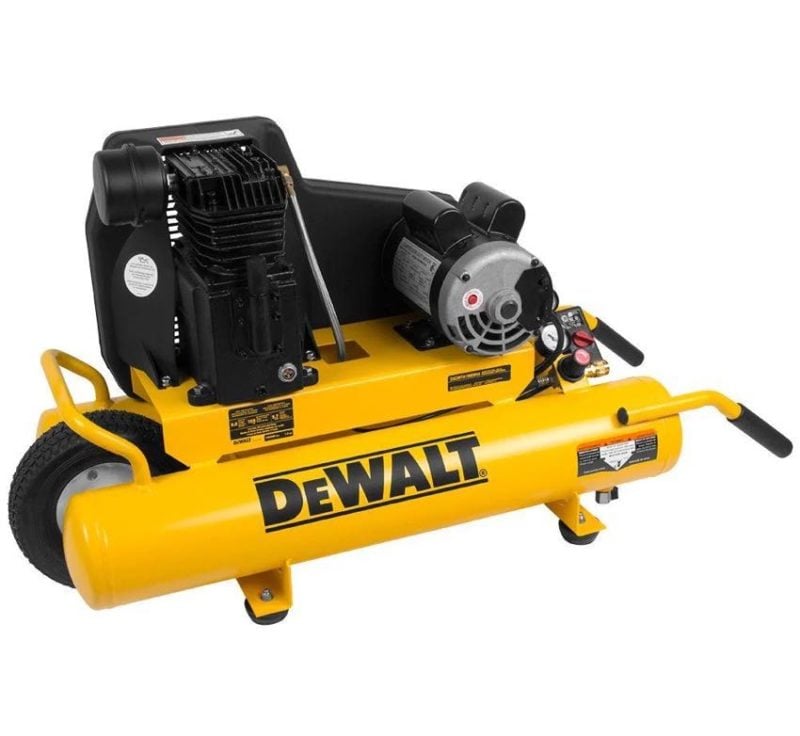

If all of those seem too large and you have no use for high-demand tools, then keeping a 4-6 gallon portable hot dog or pancake-style air compressor in your home garage might be the best solution for you.
Check out our Best Air Compressors article for our top picks across a variety of applications and uses.
Best Home Garage Air Compressor Overall – Our Top Pick
Campbell Hausfeld 2-Stage 60 Gal. Stationary Electric Air Compressor
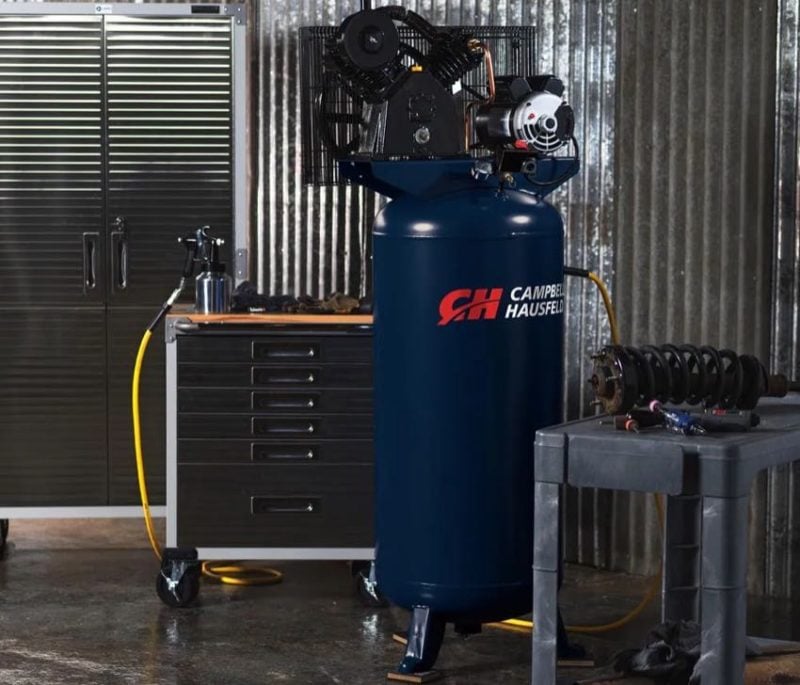
The “dirty little secret” about air compressors is that not a whole lot of companies make them. As such, you see a lot of VERY similar designs. Often, you pay a bit of premium for a particular name. With that being the case, we’ve always liked the value presented by Campbell Hausfeld. Our pick for the best home garage air compressor overall combines performance, air supply, and value.
Add it all up, and you get the 60-gallon Campbell Hausfeld 2-stage compressor (XC602100) priced around $999. This 240V single-phase compressor nets you 175 max PSI and 7.6 SCFM at 90 psi. If that’s not enough for your needs (perhaps you intend to run an air sander) then look below for our larger-capacity air compressor pick for home shops.
If you’ve never heard of Campbell Hausfeld, you may be new to air compressors. From budget systems to tall 80-gallon solutions, the company has a very wide range of solutions. In fact nearly all they do is manufacture and sell pneumatic products (and some other items like welders). This particular model is even assembled in Leitchfield, Kentucky from global materials. It comes with a limited 3-year warranty.
Great for: pneumatic ratchets, nailers, and medium-demand air tools.
Best Air Compressor for Your Home Shop
Ingersoll Rand 80-gal 5 HP 230V Single Phase Air Compressor

We’ve used quite a few stationary air compressors over the years, and Ingersoll Rand remains one of our favorite manufacturers. When you need an air compressor for your larger home shop, IR springs to mind very quickly.
They provide reliability, great features, and you get a lot of model options. For example, while we recommend the single-phase 80-gallon 2475N5 with 17.8 SCFM air delivery, you could just as easily ease up to a 40-amp model that puts out over 24 SCFM. You can also choose between single-phase and 3-phase (if you happen to have that available). Even better? Many of their products are assembled in the United States.
While Ingersoll Rand isn’t the only game in town (check out Northstar compressors at Northern Tool and Equipment as an alternative), we like them for their reliability. This shop-ready compressor runs about $2570 and features industrial-grade bearings and a cast-iron pump. It carries a 1-year warranty.
Great for: pneumatic ratchets, sanders, polishers, and high-demand air tools.
Best Portable Air Compressor for Your Home Garage
Rolair VT25BIG 2.5HP 5.3-gal Compressor with Folding Handle
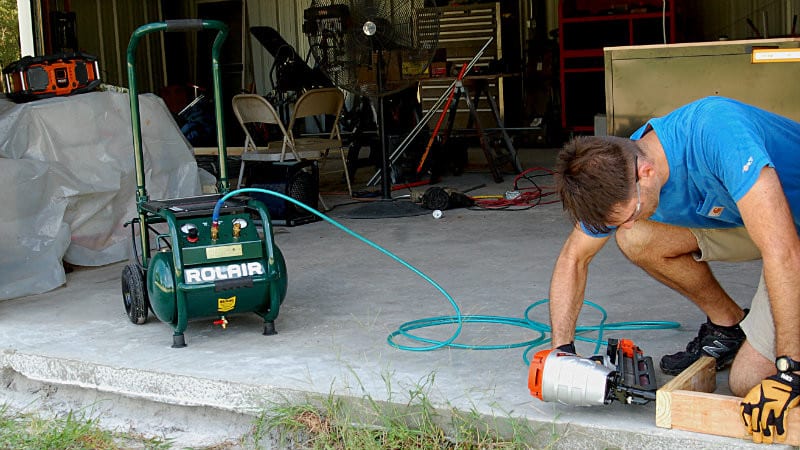
We reviewed the Rolair VT25BIG portable air compressor several years ago, and it still holds up as our favorite pick for a high-output portable air compressor. Why? Well, for just under $400 you get a 5.3-gallon 2.5HP air compressor with a 100% duty-cycle motor. That should get you 5000+ hours and outlast the warranty by a significant margin.
The Rolair VT25BIG 2.5 horsepower compressor offers outstanding air delivery while still being paired with a direct drive motor. Performance and build quality are excellent as well. The 108 pound weight is offset by a well-balanced and well-designed frame that makes portability much easier. Of course, we love the folding handle, too.
For running pneumatic nailers, you can easily run dual trim and framing nailers. One roofing nailer is no problem, but two might get ahead of air delivery. With its design, build quality, and performance, the Rolair VT25BIG absolutely gets our recommendation as the best portable air compressor for your home garage.
Great for: smaller pneumatic ratchets, nailers, and lower-demand air tools.
Best 30 Gallon Air Compressor for Your Home Garage
Husky C304H or Craftsman CMXECXM301 Portable Vertical Compressor
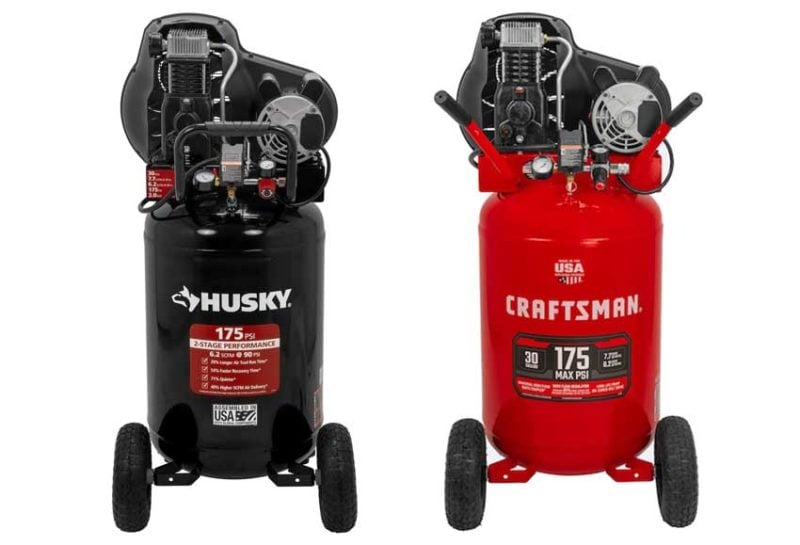
If you want to stay on the smaller side, a 30-gallon air compressor for your home garage can save a lot of space. They also give you some portability as they typically include wheels (on the vertical models). This size is also popular for gas-powered truck-mount designs, but we’ll not cover those in this article. Our pick for the best 30 gallon air compressor for a home garage gets a split vote. The reason, is because both models are licensed. For around $569 you can get the Craftsman CMXECXM301 30-gallon portable vertical compressor with 6.2 SCFM at 90 PSI.
Or, for $649 you can pick up the Husky C304H 30-gallon portable vertical compressor with an identical SCFM rating. Both use 2 HP motors that output 175 max PSI. Looking closely, you can see that both compressors very likely come out of the same factory—which is why we’re not discriminating too hard on which one you choose. Our recommendation? Look for which one is on sale.
Great for: pneumatic ratchets, nailers, and medium-demand air tools.
Air Compressor Maintenence Tips
A little regular maintenance should keep your shop or home garage air compressor working for many years. We also recommend more frequent checks than normal if your environment tends to be more dirty or filled with dust and debris. Here’s a good idea of the type of maintenance schedule you want to keep with oil-filled compressors:
| Daily | Weekly | Monthly | Every 100 Hours | |
|---|---|---|---|---|
| Check safety valve | X | |||
| Drain tank | X | |||
| Check pump oil level | X | |||
| Inspect air filter | X | |||
| Change pump oil | X | |||
| Check for oil leaks | X | |||
| Inspect drive belt | X | |||
| Check drive belt tension | X | |||
| Inspect pulley/flywheel alignment | X | |||
| Check for unusual noise/vibration | X | |||
| Air leak inspection | X | |||
| Clean exterior | X |
Manufacturers, perhaps due to an overabundance of caution or legal reasons, might recommend more frequent checks of things like air filters and drive belt inspections. Our recommendations are a bit more relaxed to accommodate practical use of these tools in a non-commercial environment. If you use your home garage air compressor daily then you may want to make some of your routines more frequent.
One thing we like to note is that you should really change the oil on an air compressor pump after the first 20 hours. This can really prolong the life of the pump by eliminating any early issues associated with manufacturing and breaking the unit in. For compressors using oil in their pumps, replace the oil after break-in with synthetic SAE30 oil that has no detergents in it.
How We Make Our Choices
Looking at the best air compressor for a home garage, we based our picks on several specific key metrics. We realize—given the vast scope of available products—that our top choices are somewhat subjective. Even so, each selection is made carefully and represents the result of careful consideration and our collective experiences as a team of reviewers. Over the years, we’ve honed our process into a system that we feel helps us deliver reliable choices when recommending products, accessories, and even power and hand tools.
We’ve each used and reviewed various compressors over a period of decades. As such, we have a lot of personal experiences to pull from when choosing the best air compressors for home shops and garages. In the end, we feel you can really rely on and trust the models we included in this article.
Options and Features
You don’t often think of options when looking at air compressors. For us, “options” means those features that make it easier to use and maintain the air compressor. On portable units, that equates to the size of the wheels and the means of moving the unit around. With stationary units, that might be the maintenance features (like the magnetic oil plug that collects foreign materials before they mess up your pump).
As noted above, we also looked at tank capacity, airflow, noise output, and duty cycle compared to similar (or similarly-priced) models. Taking a holistic view of many brands together lets us determine what products stand out with respect to the features that matter.
Duty Cycle and Run-time
No matter what size air compressor you pick, you want one that can run the tools you need it to operate. If you drain the tank too quickly and the compressor’s pump can’t refill the system quickly enough, you lose performance. Your tools won’t work the way they’re designed. That means proud nails, swirl marks, etc. You need to match the air compressor to the application.
In a home garage or shop that gets even more complicated since you can do so much more than simply drive nails. Sanding, polishing, using air ratchets—all these opportunities demand enough tank size and CFM to get the job done. The recommendations on this page include helpful information to let you know what these compressors can handle.
Value
Value always matters. How much you want to invest in a solid air compressor should relate to the type of work you want to do. However, we don’t just compare SCFM numbers and tank size and call it a day. For example, a $129 8-gallon 1.8HP hot dog compressor performs quite differently than a comparably-sized 5HP 220V model that pumps out 18.5 CFM.
You shouldn’t mind spending more for higher build quality or a compressor that runs more quietly. For that reason, we look for products that offer exceptional build quality or features. You can outspend all of our recommendations, of course. We tend to prioritize affordability over the premium “Ferrari” solutions that almost overdeliver or operate at what we might consider commercial levels.
Why You Can Trust Pro Tool Reviews
Ever check out a “review” site and you can’t tell if they actually tested the tools or if they’re just “recommending” the Amazon top sellers? That’s not us. We won’t recommend anything unless we actually have the in-hand use and experience to go along with the pick and we don’t really care who the primary retailer is. It’s all about giving you a legitimate recommendation and our honest opinion of each product.
We’ve been in business since 2008 covering tools, writing reviews, and reporting on industry news in the construction, automotive, and lawn care industries. Our Pro reviewers work in the trades and have the skills and experience to know whether tools can perform well in the field.
Each year, we bring in and review more than 250 individual products. Our team will put our hands on hundreds of additional tools at media events and trade shows throughout the year.
We consult with innovators in the technology and design of tools to gain a broader grasp of where these products fit and how they work.
We work with more than two dozen professional contractors around the United States who review products for us on real job sites and consult with us on testing methods, categories, and weighting.
The end result is information you can trust because of the editorial, scientific, and real-world professional experience we collectively utilize each and every time we pick up and test a tool.

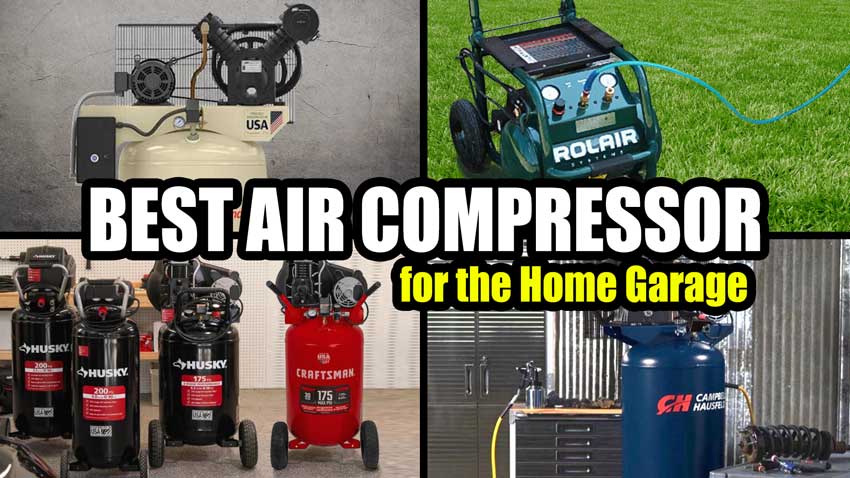
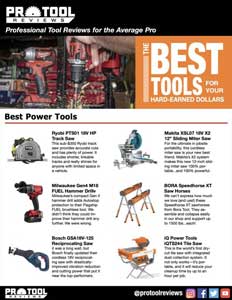

How do I meadure for a belt for a compressor belt I am having to modify and replace the notor on a fabricated mount.? And how do i choose the right diameter pulley for the motor so I dont over rev thr pumo ir work the motor too hard? Thats a lor if information and questions I know but, I Dont want to buy several just I tow return. Ill be able to move the motor side to side so pulleyis th typee m andos sizet i s the most important decision. Its a 1 inch wide belt Husky C331H… Read more »
No mention of the Makita 5200? They’re the most durable portable compressors that I’ve ever used. (I believe that both Makita and Rolair use Sunmake as a supplier, which is why they look similar.) Rolair makes great large, stationary machines, but we’ve had problems with their portable units. Pressure switches, starter capacitors, and bad paint, which begins rusting immediately. After four years of extremely heavy use, we haven’t had one problem with the Makitas.
I have a small Craftsman “hot dog” style compressor. It does well for refilling tires or running Brad nailers. If I use it to blow out dusty items such as air filters from air purifiers, then it seems to run all the time. It’s a 3 gallon 1.5 hp max(1 hp running) 95 psi cut in pressure, 125 psi cut out pressure, 2.4 SCFM@90 psi. Bore is 1.65” and it runs at 15 amps 120 volts. What of that information would let me know it would run so much? If it were a 6 gallon tank, wouldn’t it take twice… Read more »
In an otherwise excellent article, there is one sentence I have to quibble with. You wrote: “With respect to the duty cycle time, you need to ensure your compressor can use the tools you intend for the period of time you need.” That is backwards; the *tool* uses the compressor, not the other way around. When I bought my first air compressor from Sears it only had a 12 gallon tank but the 2HP, (probably 100% duty-cycle) motor and huge cylinders put out 5.9 CFM @90 PSI. It survived falling out of the back of a car when a friend… Read more »